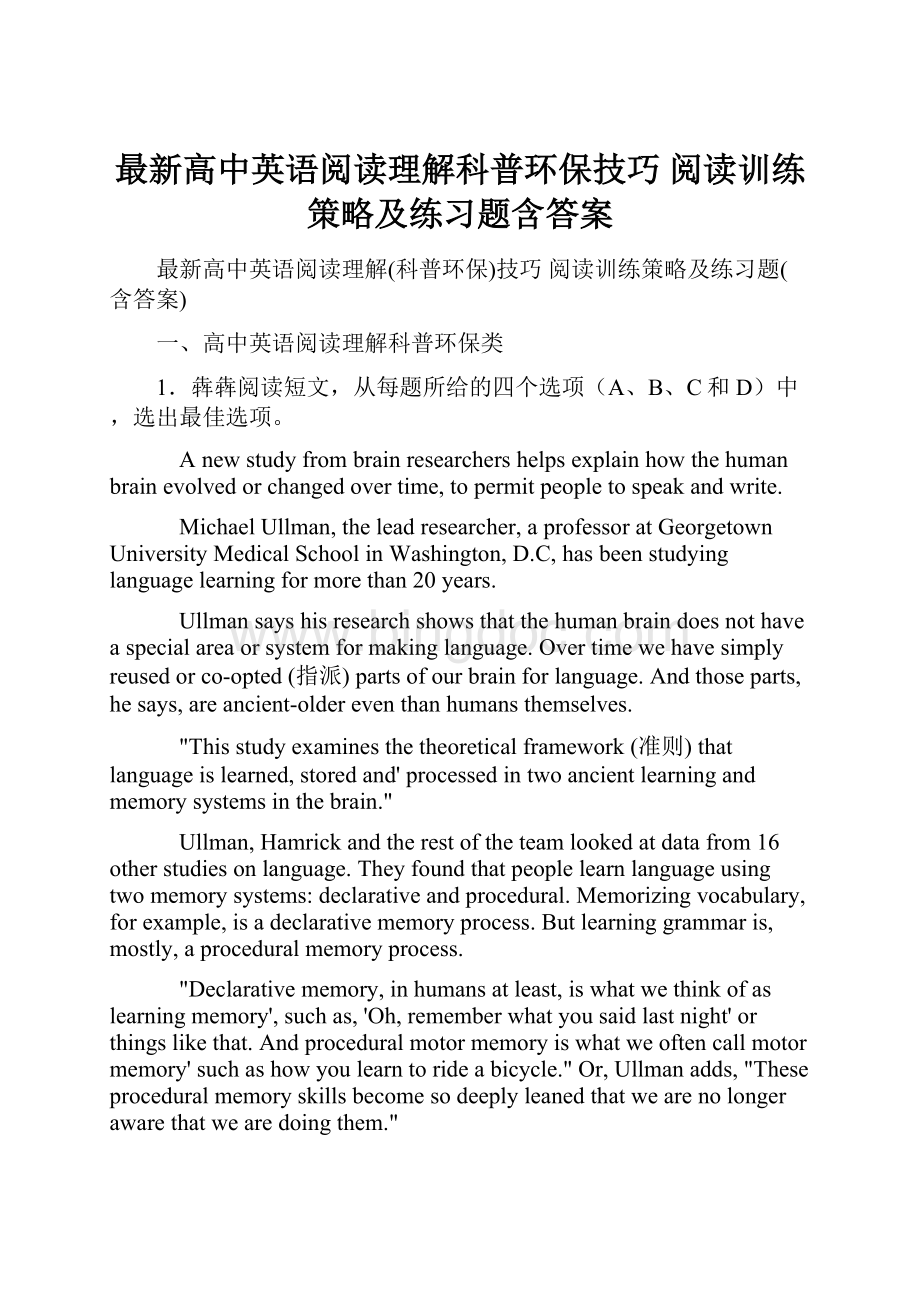最新高中英语阅读理解科普环保技巧 阅读训练策略及练习题含答案.docx
《最新高中英语阅读理解科普环保技巧 阅读训练策略及练习题含答案.docx》由会员分享,可在线阅读,更多相关《最新高中英语阅读理解科普环保技巧 阅读训练策略及练习题含答案.docx(29页珍藏版)》请在冰点文库上搜索。

最新高中英语阅读理解科普环保技巧阅读训练策略及练习题含答案
最新高中英语阅读理解(科普环保)技巧阅读训练策略及练习题(含答案)
一、高中英语阅读理解科普环保类
1.犇犇阅读短文,从每题所给的四个选项(A、B、C和D)中,选出最佳选项。
Anewstudyfrombrainresearchershelpsexplainhowthehumanbrainevolvedorchangedovertime,topermitpeopletospeakandwrite.
MichaelUllman,theleadresearcher,aprofessoratGeorgetownUniversityMedicalSchoolinWashington,D.C,hasbeenstudyinglanguagelearningformorethan20years.
Ullmansayshisresearchshowsthatthehumanbraindoesnothaveaspecialareaorsystemformakinglanguage.Overtimewehavesimplyreusedorco-opted(指派)partsofourbrainforlanguage.Andthoseparts,hesays,areancient-oldereventhanhumansthemselves.
"Thisstudyexaminesthetheoreticalframework(准则)thatlanguageislearned,storedand'processedintwoancientlearningandmemorysystemsinthebrain."
Ullman,Hamrickandtherestoftheteamlookedatdatafrom16otherstudiesonlanguage.Theyfoundthatpeoplelearnlanguageusingtwomemorysystems:
declarativeandprocedural.Memorizingvocabulary,forexample,isadeclarativememoryprocess.Butlearninggrammaris,mostly,aproceduralmemoryprocess.
"Declarativememory,inhumansatleast,iswhatwethinkofaslearningmemory',suchas,'Oh,rememberwhatyousaidlastnight'orthingslikethat.Andproceduralmotormemoryiswhatweoftencallmotormemory'suchashowyoulearntorideabicycle."Or,Ullmanadds,"Theseproceduralmemoryskillsbecomesodeeplyleanedthatwearenolongerawarethatwearedoingthem."
However,Ullmanexplainsthatthetwolong-termmemorysystemscansharetasks.And,headds,theadultbrainusesthesystemstolearnlanguageabitdifferentlythanachild'sbrain.
"Adultlanguagelearnersofasecondlanguagemayusetheirdeclarativememoryforusinggrammarpatterns.Theythinkaboutitpurposefully.Forachild,thegrammarmaycomemorenaturally.Theydon'thavetothinkaboutthegrammarrulesbeforespeaking."
Inadditiontolanguagelearners,Ullman'sstudycouldhelppeoplewhohaveabraininjurythataffectsspeakingandwriting.Thisknowledgecanalsohelpthosewhohavelearningdisabilitiessuchasdyslexia(阅读障碍).Peoplewithdyslexiahavedifficultyrecognizingwordsandsymbolsaccurately.
(1)HowdidUllmanstudyhuman'smemorysystems?
A. Byexaminingthebrainwithhisteam.
B. Bystudyinglanguagelearningoveryears.
C. Bycomparingdifferentlanguagesyearafteryear.
D. Byreferringtodatafromotherstudiesonlanguage.
(2)Whichofthefollowingisanexampleof"motormemory"?
A. Learningtomakeamodelplane.
B. Rememberingthegrammarpatterns
C. Repeatingwhatyouheard.
D. Memorizingwhatyouread.
(3)Whatdoestheunderlinedword"it"referto?
A. Declarativememory.
B. Anadultlanguagelearner.
C. Usinggrammarpatterns.
D. Asecondlanguage.
(4)What'sthemainideaofthetext?
A. Ullmanhasadvancedourlanguageunderstanding.
B. Anewresearchhelpspeoplelearnanewlanguage.
C. Learningmemoryismoreactivethanmotormemory.
D. Humanbeingslearnlanguageinprehumanareaofbrain.
【答案】
(1)D
(2)A
(3)C
(4)D
【解析】【分析】本文是一篇说明文,讲述MichaelUllman和他的团队的研究称人类大脑前区的为语言学习区,由此解开了人类大脑进化过程之谜。
在最古老的大脑学习记忆区域,陈述性记忆和运动记忆分工合作,来完成语言学习。
(1)考查细节理解。
根据第五段中的“Ullman,Hamrickandtherestoftheteamlookedatdatafrom16otherstudiesonlanguage.”可知,该团队通过研究其他语言学习的成果,得出的结论,故选D。
(2)考查推理判断。
根据第六段中的"Andproceduralmotormemoryiswhatweoftencallmotormemory'suchashowyoulearntorideabicycle."可知,程序性运动记忆就是我们常说的运动记忆,比如学习骑自行车等技能,故选A。
(3)考查词义猜测。
根据倒数第二段中的"Adultlanguagelearnersofasecondlanguagemayusetheirdeclarativememoryforusinggrammarpatterns."可知,成年语言学习者在学习第二语言时,是刻意地在使用语法句式。
所以it是指代usinggrammarpatterns,故选C。
(4)考查主旨大意。
根据第三段中的“Ullmansayshisresearchshowsthatthehumanbraindoesnothaveaspecialareaorsystemformakinglanguage.Overtimewehavesimplyreusedorco-opted(指派)partsofourbrainforlanguage.”以及全文可知,人类的语言学习是由大脑前区完成的,该区域早于人类本身。
所以选D。
【点评】本题考点涉及细节理解,词义猜测,推理判断和主旨大意四个题型的考查,是一篇科研类阅读,要求考生在捕捉细节信息的基础上,进一步根据上下文的逻辑关系,进行分析,推理,概括和归纳,从而选出正确答案。
2.犇犇阅读下列短文,从每题所给的A、B、C和D四个选项中,选出最佳选项。
Whenyouthinkbacktotheblackboardfromyourschooldays,whatcolorisit?
Chancesarethatit'sgreen.Sowhat'supwiththename?
Originally,blackboardswerereallyblack.Beforewall-sizedblackboardsexisted,late18th-centurystudentsusedtheirownminiboardsmadeofslate(石板)orpaintedwood,accordingtoConcordiaUniversity,Thosefirstboardswere,infact,black,andtheypavedthewayforthelargerones.
In1800whenaScottishheadmasternamedJamesPillanswantedhisstudentstodrawmaps,thestudentscouldn'tdrawthemapstheirteacherwantedontheirtinyboards,soPillansputseveralslatestogethertocreatealargeboard.Problemsolved!
Fromthere,theideaspreadquicklyasteacherscouldfinallyshowaconcepttothewholeclassatonetime.By1815,themassivewritingspaceswerecommonenoughtoearntheirownname:
blackboard.
Thecolorchangecameinthe1960swhencompaniessold,steelplates,coatedwithgreenenamel(漆)insteadofthetraditionaldarkslate.Thenewmaterialwaslighterandlessfragilethanthefirstblackboards,sotheywerecheapertoshipandmorelikelytosurvivethejourney.Teachersweren'tcomplainingeither.Afterall,thenew"greenboards"madethechalkpowdereasiertoerase.Plus,theenamelleftlessofaglareandthecolorwasnicertolookat.Atthatpoint,peoplestartedusingtheword"chalkboard"asamoreaccuratedescriptor,but"blackboard"stillstuckaround.
(1)Whatdidthelate18th-centurystudentsuseinclass?
A. Blackboard.
B. Chalkboard.
C. Greenboard.
D. Miniboard.
(2)Whydidtheheadmasteraskthestudentstoputtheirminiboardstogether?
A. Tomakeacomparison.
B. Tomakeenoughspace.
C. Todrawstudents'attention.
D. Toarousestudents'interest.
(3)WhichofthefollowingisNOTtheadvantageofthe"greenboard"?
A. They'relighterinweight.
B. They'remoreconvenienttotransport.
C. They'reeasiertoerasethepowder.
D. They'remoreusefulthanthetraditionalones.
(4)What'sthemainideaofthetext?
A. Introductionoftheblackboard.
B. Originoftheblackboard.
C. Coloroftheblackboard.
D. Functionoftheblackboard.
【答案】
(1)D
(2)B
(3)D
(4)C
【解析】【分析】本文是一篇说明文,通过描述黑板发展历程向读者介绍了黑板最早的时候确实是黑色的,随后慢慢发展变成了绿色。
回答了"黑板为什么是绿色的?
"这个问题。
(1)考查细节理解。
根据第一段中的,"...late18th-centurystudentsusedtheirownminiboardsmadeofslate(石板)orpaintedwood..."可知,18世纪的学生用的是“迷你板”。
故选D。
(2)考查推理判断。
根据第二段中的“ In1800whenaScottishheadmasternamedJamesPillanswantedhisstudentstodrawmaps,thestudentscouldn'tdrawthemapstheirteacherwantedontheirtinyboards,soPillansputseveralslatestogethertocreatealargeboard.
”在1800年,一名英格兰校长JamesPillans想让他的学生们画地图,但是学生们在他们的迷你板上无法画出地图,因此校长让学生把他们的迷你板拼凑在一起来制造一个大的板。
可知,校长让学生把他们的迷你板拼凑在一起是为了创造一个大的空间来画地图。
故选B。
(3)考查细节理解。
根据第三段中的"Thenewmaterialwaslighterand...morelikelytosurvivetheJourney."可知A项和B项正确;以及"Afterall,...madethechalkpowdereasiertoerase."可知C项正确;D项文章未提及。
故选D。
(4)考查主旨大意。
文章第一段前四句话点明了文章中心:
我们看到的黑板大多是绿色的,为什么叫黑板?
通读全文也可知文章主要讲述了黑板发展过程中颜色从黑色变成绿色的过程和原因。
故选C。
【点评】本题考点涉及细节理解,推理判断和主旨大意三个题型的考查,是一篇科普类阅读,要求考生在捕捉细节信息的基础上,进一步根据上下文的逻辑关系,进行分析,推理,概括和归纳,从而选出正确答案。
3.犇犇阅读理解
IfplastichadbeeninventedwhenthePilgrimssailedfromPlymouth,England,toNorthAmerica-andtheirMayflowerhadbeenstockedwithbottledwaterandplastic-wrappedsnacks,theirplasticwastewouldlikelystillbearoundfourcenturieslater.Atlanticwavesandsunlightwouldhavewornallthatplasticintotinybits.Andthosebitsmightstillbefloatingaroundtheworld'soceanstoday,waitingtobeeatenbysomefishoroyster,andfinallyperhapsbyoneofus.
Becauseplasticwasn'tinventeduntilthelate19thcentury,anditsproductiononlyreallytookoffaround1950,wehaveamere9.2billiontonsofthestufftodealwith.Ofthat,morethan6.9billiontonshavebecomewaste.Andofthatwaste,asurprising6.3billiontonsnevermadeittoarecyclingbin-thefigurethatshockedthescientistswhopublishedthenumbersin2017.
Nooneknowshowmuchunrecycledplasticwasteendsupintheocean,theearth'slastsink.In2015,JennaJambeckaUniversityofGeorgiaengineeringprofessor,caughteveryone'sattentionwitharoughestimatebetween5.3millionand14milliontonsofplasticwasteeachyearjustcomefromcoastalregions.
Meanwhile,oceanplasticisestimatedtokillmillionsofmarine(海洋的)animalseveryyear.Nearly700species,includingendangeredones,areknowntohavebeenaffectedbyit.Someareharmedvisibly,stuckbyabandonedthingsmadeofplastic.Manymoreareprobablyharmedinvisibly.Marinespeciesofallsizes,fromzooplanktontowhales,noweatmicroplas-tics,thebitssmallerthanone-fifthofaninchacross.
"Thisisn'taproblemwherewedon'tknowwhatthesolutionis,"saysTedSiegler,aVermontresourceeconomistwhohasspentmorethan25yearsworkingwithdevelopingnationsongarbage."Weknowhowtopickupgarbage.Anyonecandoit.Weknowhowtodealwithit.Weknowhowtorecycle."It'samatterofbuildingthenecessaryinstitutionsandsystems,hesays,ideallybeforetheoceanturnsintoathinsoupofplastic.
(1)WhydoestheauthormentionthePilgrimsinparagraph1?
A. Toproveplasticwasdifficulttoinvent.
B. Tointroducewhatmarineanimalslikeeating.
C. TotellthePilgrimscontributedalottothemarineprotection.
D. Toshowplasticwastehasalastingeffectontheocean.
(2)What'sthemaintroublemarineanimalsfaceaccordingtothetext?
A. Lackingprotection.
B. Beingstuckbyplasti